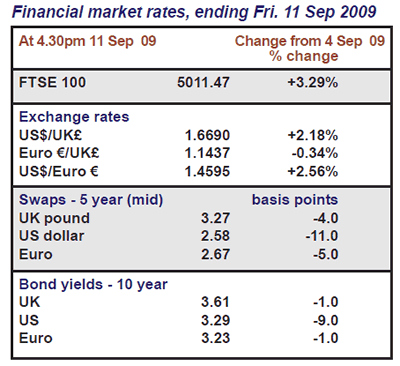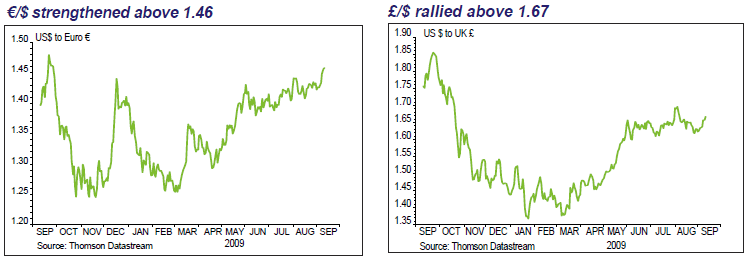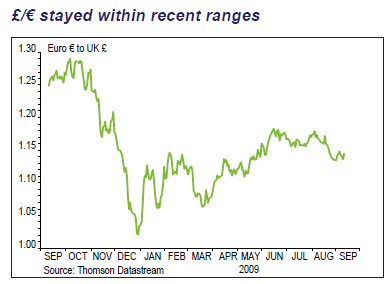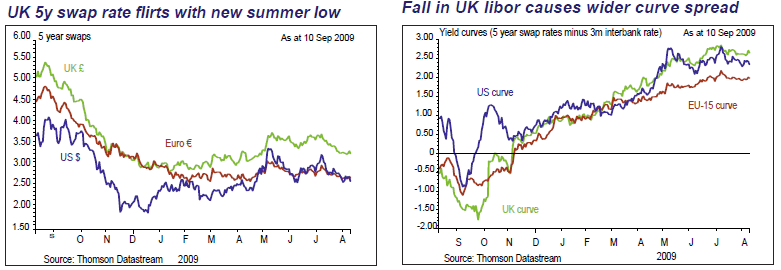U.S. Dollar Extends Fall, FTSE Closes Above 5,000
Stock-Markets / Financial Markets 2009 Sep 11, 2009 - 11:34 AM GMTBy: Lloyds_TSB
 Financial market review - Foreign Exchange - The USD came under renewed selling pressure this week, reacting to a further decline in US 3-month libor and equity market optimism. A fall in the VIX volatility index implied greater demand for higher risk assets. Interestingly, the JPY and CHF outperformed the commodity and high yielding currencies like the CAD, AUD and NOK. Sterling caught up with the move and ended the week among the top three gainers. GBP/ USD vaulted 1.67, supported by stronger UK data and the BoE decision to leave Bank rate on hold at 0.50% and the QE target at £175bn. EUR/USD crossed 1.46 and USD/CHF fell below 1.05.
Financial market review - Foreign Exchange - The USD came under renewed selling pressure this week, reacting to a further decline in US 3-month libor and equity market optimism. A fall in the VIX volatility index implied greater demand for higher risk assets. Interestingly, the JPY and CHF outperformed the commodity and high yielding currencies like the CAD, AUD and NOK. Sterling caught up with the move and ended the week among the top three gainers. GBP/ USD vaulted 1.67, supported by stronger UK data and the BoE decision to leave Bank rate on hold at 0.50% and the QE target at £175bn. EUR/USD crossed 1.46 and USD/CHF fell below 1.05.
 The positive correlation of GBP with greater risk appetite returned with a vengeance this week and helped GBP/USD to reverse a great deal of the losses incurred in August. Broad-based USD weakness, stronger UK manufacturing output data and the BoE decision to leave Bank rate and the QE target unchanged helped to spur demand for GBP/USD. The currency pair rose four trading days in succession and capped the sharp appreciation with a move above 1.67 on Friday, a one-month high.
The positive correlation of GBP with greater risk appetite returned with a vengeance this week and helped GBP/USD to reverse a great deal of the losses incurred in August. Broad-based USD weakness, stronger UK manufacturing output data and the BoE decision to leave Bank rate and the QE target unchanged helped to spur demand for GBP/USD. The currency pair rose four trading days in succession and capped the sharp appreciation with a move above 1.67 on Friday, a one-month high.
The outperformance of GBP/USD vs EUR/USD resulted in a fall in EUR/GBP below 0.8750 (GBP/EUR above 1.1428), despite a widening in EU/UK 2y yields (owing to a change in the German 2y benchmark). GBP only lost ground this week vs the JPY and CHF, incidentally the two best performers of the week in the G10. A breakout in USD/JPY below 92.0 squeezed the pair below 0.91 to a seven-month low.
Stronger than expected economic data from China for August and strong weekly portfolio investment flow data for Japan helped to boost demand for the JPY. It is unclear at this stage how tolerant Japanese officials are of the currency’s strength, and we look forward to hear from the BoJ next week of how it judges the impact of a strong JPY on the economy. The failure of the AUD, NZD and CAD to capitalise on bullish Chinese retail sales, production and lending data is somewhat puzzling but could indicate that participants with exposure to commodity and high yielding currencies are moving to the sidelines following strong gains this summer, and are heeding the threat of central bank intervention (RBNZ, BoC). Uncertainty over the timing of a possible rate hike by the RBA and dovish comments by the RBNZ may also have tempered some buying interest. The Chinese data failed to arrest the rally in EUR/CNY above 9.97 and GBP/CNY above 11.40. This could squeeze euro zone and UK based exporters.
Strong gains for Russian equities (+6%) handed the Russian rouble the biggest gain in emerging markets. EUR/PLN firmed 1.8% as 10y yield spreads over Germany widened considerably following S&P’s warning about Poland’s spiralling public deficit and growing risks of non-performing loans in the banking sector. EUR/TRY rose 2.3% as markets looked beyond a surprise July current account surplus to a planned meeting with the IMF next month.

Interest rate market review - bonds, cash and swaps
 We saw a mixed performance in global bond markets this week, with US Treasuries out performing gilts and bunds led by a strong show of (overseas and dealer) support at the three Treasury note auctions, and a bond friendly assessment of US inflation and wage pressures from the Fed Beige Book. UK yields traded in a narrow range but a high degree of volatility was witnessed in swaps, where 5y rates reversed 10bps after hitting a 3.39% high mid-week. The launch of a new German benchmark Schatz was credited for a jump in 2y yields to 1.25% and the underperformance vs Treauries and gilts. 3-month Libor rates pursued their decline in the UK, the US and the euro zone, paving the way for a further narrowing of 3-month libor/ OIS spreads to levels seen prior to when money and credit markets seized up in August 2007.
We saw a mixed performance in global bond markets this week, with US Treasuries out performing gilts and bunds led by a strong show of (overseas and dealer) support at the three Treasury note auctions, and a bond friendly assessment of US inflation and wage pressures from the Fed Beige Book. UK yields traded in a narrow range but a high degree of volatility was witnessed in swaps, where 5y rates reversed 10bps after hitting a 3.39% high mid-week. The launch of a new German benchmark Schatz was credited for a jump in 2y yields to 1.25% and the underperformance vs Treauries and gilts. 3-month Libor rates pursued their decline in the UK, the US and the euro zone, paving the way for a further narrowing of 3-month libor/ OIS spreads to levels seen prior to when money and credit markets seized up in August 2007.
UK economic data and the BoE had no major impact on gilts as investors concentrated on trends in equities and the US Treasury auctions instead. There were positive data surprises in Halifax house prices (+0.8%) and August industrial output (+0.8%). The NIESR reported that the economy expanded by 0.2% in the three months to August. This marked the first rise since May 2008. Input prices were stronger than forecast in August showing a gain of 2.2% m/m, but subdued output prices - headline and core prices rose 0.2% m/ m – testify to the difficulty manufacturers are having in passing on price increases, despite the recent improvement in manufacturing conditions. We expect a tame inflation outlook to be underlined in the CPI and average earnings data next week.
The BRC reported a drop in like-for-like annual retail sales of 0.1% in August. The BoE kept Bank rate on hold at 0.50% and made no changes to its QE target (£175bn). On Tuesday , the £3.75bn 2019 gilt auction was covered a solid 2.15 times. The gilt will be one of the issues included in the BoE’s purchase program next week Wednesday. Overall, the BoE bought £4.2bn of gilts this week, pushing the total amount purchased in operations since March to £143.37bn. UK 5y swaps closed the week 4bps lower at 3.27% as 3-month libor fell 4bps to 0.63%, leading to a compression in the libor spread over Bank rate to 8bps. The Enel spA jumbo debt issue raised £850mn of 2024 paper at 165bp over gilts and £1.4bn in 2040 paper at 155bp over.
US Treasury yields flirted with this summer's lows for a second week as prices rallied on strong auctions and ignored the rise in equities. The $70bn sale of 3y, 10y and 30y paper went much better than many had expected as dealers including overseas bidders looked through a fall in the USD to a new 2009 low. Short positioning and a bond friendly assessment of the inflation backdrop in the Fed Beige Book helped to underpin prices and contributed to a flattening of the 2y/10y yield curve to 243bps. A record $21.6bn drop in consumer credit in July underscored ongoing deleveraging by households and the headwinds the economy still faces on the road to a (sustainable) recovery. A widening in the US trade deficit to $32.0bn in July (will subtract from GDP) and Moody's report that US banks will write down a further $350bn in 2009 and 2010 supported lower yields. 5y swaps finished the week 11bps lower at 2.58%. 10y swap spreads narrowed to 17bps on stronger risk appetite.
Euro zone 2y yields fell to a new low below 1.05% early in the week, but the launch of a new benchmark September 2011 Schatz later in the week propelled 2y yields back up to 1.25%. Germany will sell USD denominated sovereign paper next week for the first time in more than four years in a 3-year deal worth roughly $3bn at 20-25bps under libor. The jumbo Enel spA deal raised €1.5bn of 2015 paper at 95bps over mid-swaps and €2.5bn of 2022 paper at 130bps. German July factory orders data surprised to the upside with a 3.5% m/m gain. Industrial output surprisingly fell 0.9% in the same month. 5y swaps finished the week 5bps lower at 2.67%.

Kenneth Broux, Economist
Altaz Dagha, Economist
For more information: Emile Abu-Shakra Manager, Media Relations Lloyds TSB Group Media Relations Tel 020 7356 1878 http://www.lloydstsbcorporatemarkets.com/
Lloyds TSB Archive |
© 2005-2022 http://www.MarketOracle.co.uk - The Market Oracle is a FREE Daily Financial Markets Analysis & Forecasting online publication.



